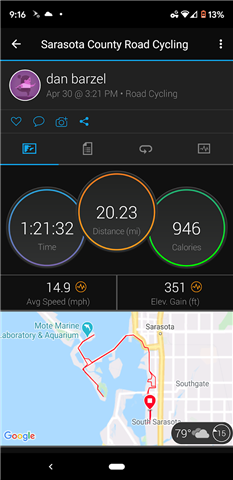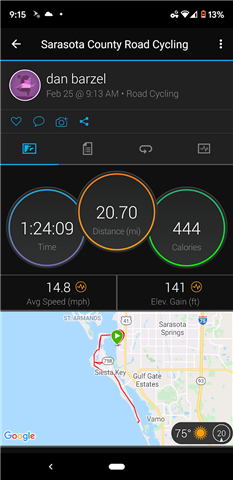Different calorie burn reading with/without hrm. 50 mile bike read without = 2500 cals, with 1200 cals, any thoughts?
It is a bit like comparing apples and oranges. First of all the duration differs by more than 20 minutes, and unlike what you wrote, the duration matters, besides others because the total calories contain also the RMR for the entire time of the ride. Then the speed, distance, and the elevation gain differ too, meaning there was a difference in active Calories as well.
Try making two identical activities. One with HRM, and the other without it. They do not need to be that long like these ones. It is enough to make two short identical circuits, trying to keep the same speed (and hence also the time).
When I enter the ride data to an online bike calories calculator, using age 40, heigth 180cm, weight 80kg, I get also slightly over 1300 kcal for the second ride (and a bit under 1000 kcal for the first one). Unfortunately, the calculator does not take in account the elevation gain difference. There are dozens of other calculators available, so you may perhaps find one that is more specific and more accurate.
However, the non-HRM estimation seems to be all right at Garmin. The reason for getting much lower values with the HRM may be for example that you rode the trip with less effort than an average person. Another possibility is that the HRM did not record your HR correctly. Yet another possibility (and a rather common one) is that you did not have the HRM turned on during the sleep and during resting periods on the day of your ride, leading to an increased average Resting HR value for given day, and hence decreased Calories results.
I don't wear the HRM during the day, I wear a chest strap when I ride (or did until the garmin HRM failed, replaced strap, never worked again, and the 520 never paired with another HR strap again...)
I'm sorry I don't find the theories convincing, except for the fact I may use less energy than the average person (hard to believe for a 67 year old, but possible)
here are 2 nearly identical rides - a little elevation diff but not 500 cal worth.
I dunno. ....
I doubt you can use many of the reason except
 the one about me being "better than average"
the one about me being "better than average"
I don't wear the HRM during the day, I wear a chest strap when I ride
The Calories calculation is depending on the ratio HR / avg RHR (Average Resting HR for given) and on the ratio VO₂Max / rest. VO₂. It means that when not measuring the RHR and VO₂ at rest, the avg RHR and resting VO₂ are hight, the resulting ratio low, and in consequence the Calories low too.
Try wearing the HRM for some time during deep rest, before the ride, and see whether the values increase. Also make sure all the personal data including the Activity Class are entered correctly in your User Profile.
You also need a HRM chest belt supporting the HRV feature (Heart Rate Variability), otherwise the VO₂ readings won't work properly.
Have a look at the article How calorie measurement works on Garmin fitness devices for more information.
The firstbeat explanation says "calculation uses user inputted variables including gender, height, weight and fitness class. It then combines this data with heart rate information from the ANT+ heart rate strap. Specifically, it evaluates the time between heart beats (beat to beat) to determine estimated MET (Metabolic Equivalent), which in turn is used determine actual work expenditure."
So if it's within 10%, the hr monitor method is close
And the non hr method is way off ?
I still SMH
And the non hr method is way off ?
As I wrote, the non-HR estimate looks pretty OK, according to diverse online bike Calorie calculators - but they are only estimates, the reality may differ. Also, the HR belt needs to support the HRV detection (the beat to beat data), which is not the case with every HR belt. And then there is the issue with the resting VO₂ and RHR, which can infulence the calculation too.